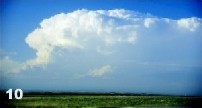|
PREV NEXT
Supercells
 The
supercell is a special storm type in which the system maintains an intense,
steady state for many hours. A highly organized circulation, continuous large
updraft, control over the surrounding air, and magnified size and impact make
this a fascinating but dangerous cloud complex. It accounts for most of the
serious severe events we experience, including very large hail and long-lived,
damaging tornadoes. Fortunately, we can often recognize this type by the degree
of control and organization shown in the cloud and sky features, allowing us
to prepare for its severe potential. The
supercell is a special storm type in which the system maintains an intense,
steady state for many hours. A highly organized circulation, continuous large
updraft, control over the surrounding air, and magnified size and impact make
this a fascinating but dangerous cloud complex. It accounts for most of the
serious severe events we experience, including very large hail and long-lived,
damaging tornadoes. Fortunately, we can often recognize this type by the degree
of control and organization shown in the cloud and sky features, allowing us
to prepare for its severe potential.
In a supercell, the powerful updrafts reach great heights, forming sharp-edged
anvils that blow far downwind aloft. This carries precipitation well forward
of the inflow region, allowing the storm to survive for many hours. Other telling
features include persistent overshooting tops, rock-hard towers, large backsheared
anvils and banding or striations around the base. The flanking line is often
short and steep, with individual updraft towers very close together or merged
in appearance. One other important feature that defines every supercell and
is discussed in detail on page 30 is the presence of a rotating updraft column
called a mesocyclone, with its visual manifestation -the wall cloud - below
the rain-free base.
How storms move and change
The way a storm moves is the result of its growth pattern, in combination with
the motion caused by the winds carrying the cloud along. If a cell simply formed,
then stopped growing, it would drift with the winds aloft and gradually evaporate.
Continuous new growth, or regeneration, causes the core to shift (usually southward)
at an angle to cloud motion, and the rate of growth as well as the direction
of the surface wind ahead of the system (the storm's inflow) affect the direction
and degree of this shift. Don't be distracted by the direction of motion of
small cumulus or the anvil cloud's instead, keep an eye on the rain-free
base beside the rain core.
Weaker storms travel roughly with the winds aloft. Stronger storms can move
almost at right - angles to the cloud motion. A less common motion occurs when
a storm has its main inflow on the NW side (usually when the surface wind is
from the NW-NE), which causes it to shift to the N-NE. In either case, the shift
is always on the side where updrafts/new towers are adding to the system. Storms
grow toward the inflow side,which can be seen by the presence of low, dark bases.

A regenerating storm system is one that recreates itself internally or in
small increments so as to maintain its overall characteristics. All severe
storms employ this action to maintain themselves for extended periods. By
comparison, propagation occurs when the system is "reborn" nearby,
or when it collapses and induces new storms to form. (Compare the close, successive
steps of regeneration in photo 31 with the propagation and completely new
phase in photo series 17-20).
A common form of propagation is the rapid growth of separate, new cells -
either on the flanking line 13 or on an outflow boundary, created when the
original storm system's collapse sends out a surge of cool air. When a system
propagates, the new storm matures up to an hour after the original one ceases.
In stronger, sustained systems, propagation occurs when regeneration is interrupted
by a brief weakening phase. From a distance, you might see a gap in the rain
curtain, anvil, etc.or see no evidence at all. However,underneath the storm
the weakening will be apparent from smaller hail, less lightning, more cold
outflow, or a brief letting-up of the intensity.
PREVTOP NEXT
Created :
2002-08-26
Modified :
2002-12-19
Reviewed :
2002-12-19
Url of this page : http://www.msc.ec.gc.ca
/education/severe_weather/page08_e.cfm

The Green LaneTM,
Environment Canada's World Wide Web Site.
|